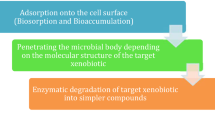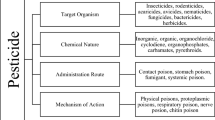Abstract
Lindane or γ- hexachlorocyclohexane (γ-HCH) is a chlorinated pesticide and its toxic effects on biota necessitate its removal. Microbial degradation is an important process for pesticide bioremediation and the role of soil fungi in recycling of organic matter prompted us to study the biodegradation of lindane using fungi. This study aims at enrichment, isolation and screening of soil fungi capable of metabolizing lindane. Two Fusarium species (F. poae and F. solani) isolated from the pesticide contaminated soil showed better growth on the plates supplemented with lindane as a sole carbon source, when compared with the growth performance of other fungal isolates from the same contaminated soil. However, ANOVA revealed a significant difference in fungal biomass production in both F. poae (F = 22.02; N = 15; P < 0.001) and F. solani (F = 268.75; N = 15; P < 0.001) across different lindane concentrations (0–600 μg ml−1). Growth of both Fusarium sp. was maximum at a lindane concentration of 100 μg ml−1, while minimum at 600 μg ml−1 concentrations. Results on the time dependent release of chlorine by the Fusarium strains in the presence of various concentration of lindane showed the highest mineralization of the pesticide on 10th day of incubation. Time dependent variations in the release of chlorine from 1st to 10th day by both the selected fungal strains were found to be statistically significant. A significant positive relationship exists between fungal biomass increase and chlorine release existed for both F. solani (R² = 0.960) and F. poae (R² = 0.628). The results of gas chromatograph analysis of γ- HCH confirmed the biodegradation and utilization of γ- HCH by F. poae and F. solani. The data on lindane degradation by the two fungal strains demonstrated that the biodegradation of lindane by F. solani (59.4%) was slightly higher than that by the F. poae (56.7%).






Similar content being viewed by others
References
Abhilash PC, Singh N (2010) Withania somnifera-dunal mediated dissipation of lindane from simulated soil: implications for rhizoremediation of contaminated soil. J Soils Sediments 10:272–282
Benimeli CS, Castro GR, Chaile AP, Amoroso MJ (2007) Lindane uptake and degradation by aquatic Streptomyces sp M7. Int Biodeterior Biodegrad 59:148–155
Bergmann JG, Sanik J Jr (1957) Determination of trace amounts of chlorine in naptha. Anal Chem 29:241–243
Bhalerao TS, Puranik PR (2007) Biodegradation of organochlorine pesticide, endosulfan, by a fungal soil isolate, Aspergillus niger. Inter Biodeterio Biodegrad 59:315–319
Bhuyan S, Sreedharan B, Adhya TK, Sethunathan N (1992) Accelerated aerobic degradation of γ- bodegradation of Hexachlorocyclohexane isomers in water and soil slurry. J Agric Food Chem 50:5070–5076
Botella B, Crespo J, Rivas A, Cerrillo I, Olea-Serrano MF, Olea N (2004) Exposer of women to organochlorine pesticide in Southern Spain. Environ Res 96:34–40
Cuozzo SA, Rollan GG, Abate CM, Amoroso MJ (2009) Specific dechlorinase activity in lindane degradation by streptomyces sp. M7. World J Microbiol Biotecnol 25:1539–1546
Elcey CD, Kunhi AAM (2010) Substantially enhanced degradation of hexachlorocyclohexane isomers by a microbial consortium on acclimation. J Agric Food Chem 58:1046–1054
Fatoki OS, Awofolu RO (2003) Methods for selective determination of persistent organochlorine pesticide residues in water and sediments by capillary gas chromatography and electron-capture detection. J Chromatogr A 983:225–236
Fretzner S, Lingens F (1994) Bacterial dehalogenases: biochemistry, genetics and biotechnological applications. Microbiol rev 58:641–685
Gilman JC (1959) A manual of soil fungi. Iowa State College Press, Ames
Hestberg H, Willumsen P, Christensen M, Andersen O, Jacobsen C (2003) Bioaugmentation of tar-contaminated soil under field condition using Pleurotus ostreatus refuse from commercial mushroom production. Environ Toxicol Chem 22:692–698
Hewitt HG (1998) Fungicide in crop protection. CAB International, UK
Itawa H, Tanabe S, Sakai N, Tatsukawa R (1993) Distribution of persistent organocholrine in the oceanic air and surface seawater and the role of ocean on their global transport and fate. Environ Sci Technol 27:1080–1089
MaecK T, Kotrba P, Svatos A, Novakova M, Demnerova K, Mackova M (2008) Novel roles for genetically modified plants in environmental protection. Trends Biotechnol 26:146–152
Manickam N, Reddy MK, Saini HS, Shanker R (2008) Isolation of hexachlorocyclohexane-degrading Sphingomonas sp. By dehalogenase assay and characterization of genes involved in γ-HCH degradation. J Appl Microbiol 104:952–960
Mougin C, Pericaud C, Dubroca J, Ashter M (1996) Biotransformation of the insecticide lindane by the white rot basidiomycetes Phanerochaete chrysosporium. Pest Sci 47:51–60
Mougin C, Pericaud C, Malosse C, Laugero C, Ashter M (1999) Biotransformation of the insecticide hexachlorocyclohexane in suspension of flooded and non- flooded soil pretreated with hexachlorocyclohexane. Biol Fert Soils 12:279–284
Nagpal V, Srinivasan MC, Paknikar KM (2008) Biodegradation of γ- hexachlorocyclohexane (Lindane) by a non- white rot fungus Conidiobolus 03-1-56 isolated from litter. Indian J Microbiol 48:134–141
Pazou EYA, Boko M, van Gestel CAM, Ahissou H, Laleye P, Akpona S, van Hattum B, Swart K, van Straalen NI (2006) Organochlorine and organophosphorous pesticide residues in the Oueme river catchment in the the Republic of Benin. Environ Int 32:616–623
Pointing S (2001) Feasibility of bioremediation by white rot fungi. Appl Microbiol Biotechnol 75:313–321
Rigas F, Papadopoulou K, Drista V, Marchant R (2005) Bioremediation of Lindane by Pleurotus ostreatus via central composite design. Environ Int 31:195–196
Shah MM, Barr DP, Chung M, Aust SD (1992) Use of white rot fungi in the degradation of environmental chemicals. Toxicol Let 6465:493–601
Siddique T, Okeke BC, Frankenberger WT Jr (2003) Enrichment and isolation of Endosulfan- degradaing microorganisms. J Environ Qual 32:47–54
Singh BK, Kuhad RC (1999) Biodegradaton of lindane(γ- Hexachlorocyclohexane) by the white-rot fungus Trametes hirustus. Lett Appl Microbiol 28:238–241
Singh BK, Kuhad RC (2000) Degradation of insecticide lindane (γ-HCH) by white- rot fungi Cythus bulleri and Phanerochaete sordida. Pest Manag Sci 56:142–146
Tekere M, Ncube I, Read JS, Zvauya R (2001) Growth, dye degradation and lignolytic activity studies on Zimbabwean white rot fungi. Enzyme Microb Technol 28:420–426
Tekere M, Ncube I, Read JS, Zvauya R (2002) Biodegradation of the organochlorine pesticide lindane, by a sub- tropical white rot fungus in batch and packed bed bioreactor system. Environ Technol 23:199–206
Waite DT, Gurprasad NP, Sproull JF, Quiring DV, Kotylac MW (2001) Atmospheric movements of lindane γ- hexachlorocyclohexane from canola fields planted with treated seed. J Environmen Quality 30:768–775
Xue N, Zhang D, Xu X (2006) Organochlorinated pesticide multiresidues in surface sediments from Beijing Guanting reservoir. Water Res 40:183–194
Yang R, Ji G, Zhoe Q, Yaun C, Shi J (2005) Occurrence and distribution of organochlorine pesticides (HCH and DDT) in sediments collected from East China Sea. Environ Int 31:799–804
Acknowledgments
We are thankful to Dr. S. K. Diwedi (Associate Professor, Department of Environmental Science, Babasaheb Bhimrao Ambedkar University, Lucknow) for his supports during identification of fungal isolates. Financial support to Ms Veena as a Rajiv Gandhi National Fellowship provided by Union Grant Commission, New Delhi is gratefully acknowledged.
Author information
Authors and Affiliations
Corresponding author
Rights and permissions
About this article
Cite this article
Sagar, V., Singh, D.P. Biodegradation of lindane pesticide by non white- rots soil fungus Fusarium sp.. World J Microbiol Biotechnol 27, 1747–1754 (2011). https://doi.org/10.1007/s11274-010-0628-8
Received:
Accepted:
Published:
Issue Date:
DOI: https://doi.org/10.1007/s11274-010-0628-8




